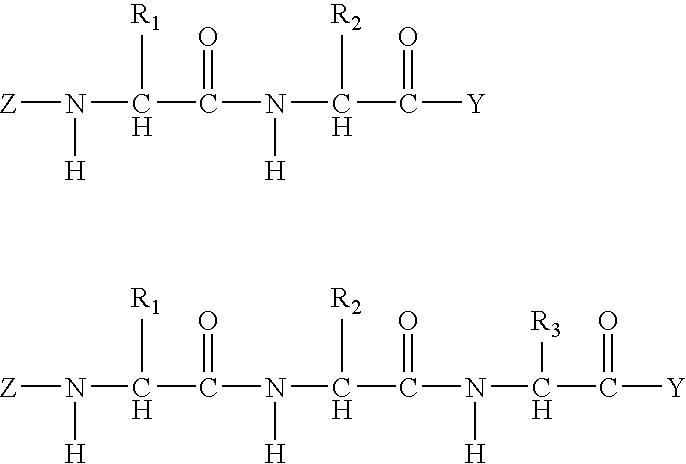Silane coating compositions, coating systems, and methods
a technology of silane and composition, applied in the field of silane coating composition, coating system, and method, can solve problems such as damage or even device failur
- Summary
- Abstract
- Description
- Claims
- Application Information
AI Technical Summary
Benefits of technology
Problems solved by technology
Method used
Image
Examples
example 1
Formation of (4-benzoylbenzoyl)aminopropyltrimethoxy Silane (BBA-Si)
[0112] 4-Benzoylbenzoic acid (BBA) was added to a dry flask equipped with reflux condenser and overhead stirrer, followed by the addition of thionyl chloride and toluene. Dimethylformamide was added and the mixture was heated at reflux for a period of time. After cooling, the solvents were removed under reduced pressure and the residual thionyl chloride was removed by three evaporations using toluene. The product, 4-benzoylbenzoyl chloride (BBA-CL), was recrystallized from 1:4 toluene:hexane and was dried in a vacuum oven.
[0113] 3-aminopropyltrimethoxysilane, triethylamine, and chloroform are introduced into a three neck round bottom flask under nitrogen gas. The mixture was cooled in an ice bath. BBA-Cl dissolved in chloroform was added dropwise with stirring. The ice bath was removed after addition and the mixture was further stirred for two hours. 4-benzoylbenzoyl)aminopropyltrimethoxy silane (BBA-Si) was isola...
example 2
Preparation of Tetrakis (4-benzoylbenzyl ether) of Pentaerythritol (tetra-BBE-PET)
[0115] Pentaerythritol (Aldrich, St. Louis, Mo.) (2.0 g; 14.71 mmole; dried at 60° C. at <1 mm Hg for 1 hour), 4-bromomethylbenzophenone (20.0 g; 72.7 mmole; prepared by free radical bromination of 4-methylbenzophenone (Aldrich, St. Louis, Mo.)), 80% (w / w) sodium hydride in mineral oil (Aldrich, St. Louis, Mo.) (NaH 1.23 g; 41.0 mmole), and tetrahydrofuran (“THF”, 120 ml) were refluxed for 34 hours in an argon atmosphere. An additional amount of 80% NaH (2.95 g; 98.3 mmole) was then added to the reaction mixture, and the mixture refluxed for an additional 7 hours under argon. The reaction was quenched by the addition of 8 ml of glacial acetic acid (HOAc). The quenched reaction was centrifuged to aid in the removal of THF insolubles.
[0116] The liquid was decanted, and the insolubles were washed with three 50 ml portions of chloroform (CHCl3). The decanted liquid (mainly THF) and the CHCl3 washes were ...
example 3
Coating of a Silicon Substrate with a Two Component Base Coating Layer Solution and Parylene
[0118] A rectangular piece of silicon (“substrate”) is placed in a small vessel containing isopropyl alcohol (IPA) and is sonicated. Next, the substrate is wiped with IPA followed by sonication in a detergent solution. The substrate is rinsed in hot tap water to remove most of the detergent, then sonicated in hot tap water. The substrate is rinsed in deionized water followed by sonication in deionized water. The substrate is then sonicated in IPA followed by drying at room temperature.
[0119] To make a base layer coating solution, IPA is added to a glass beaker with a TEFLON® coated stir bar and stirred. 1,4-bis(trimethoxysilylethyl)benzene is added followed by tetra-BBE-PET (prepared as in Example 2) dissolved in NMP (N-methyl pyrrolidone) and allowed to mix. Deionized water is added slowly to the solution. The resulting solution is thoroughly mixed.
[0120] To apply the base coating layer, ...
PUM
| Property | Measurement | Unit |
|---|---|---|
| Pressure | aaaaa | aaaaa |
| Hydrophobicity | aaaaa | aaaaa |
Abstract
Description
Claims
Application Information
 Login to View More
Login to View More - R&D
- Intellectual Property
- Life Sciences
- Materials
- Tech Scout
- Unparalleled Data Quality
- Higher Quality Content
- 60% Fewer Hallucinations
Browse by: Latest US Patents, China's latest patents, Technical Efficacy Thesaurus, Application Domain, Technology Topic, Popular Technical Reports.
© 2025 PatSnap. All rights reserved.Legal|Privacy policy|Modern Slavery Act Transparency Statement|Sitemap|About US| Contact US: help@patsnap.com



